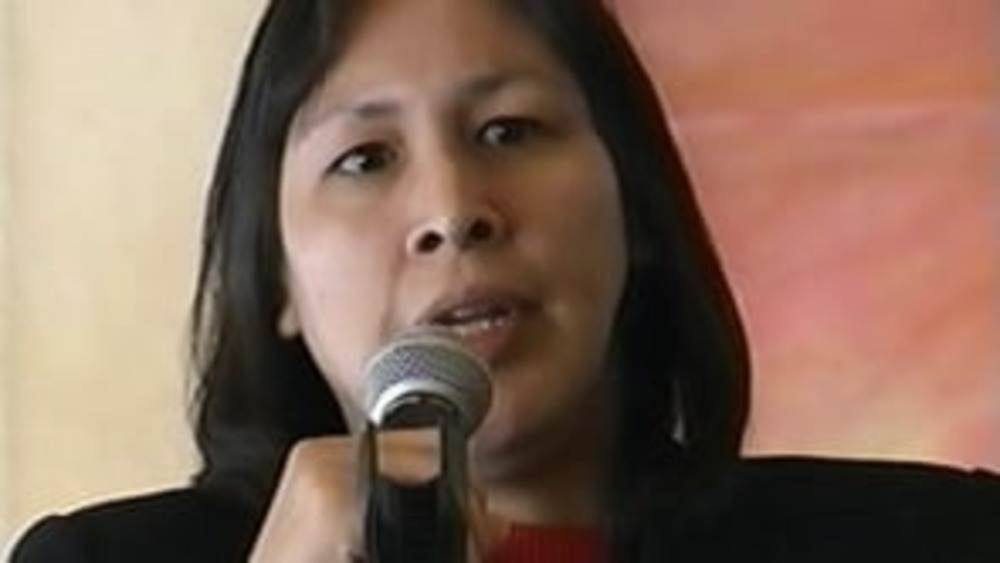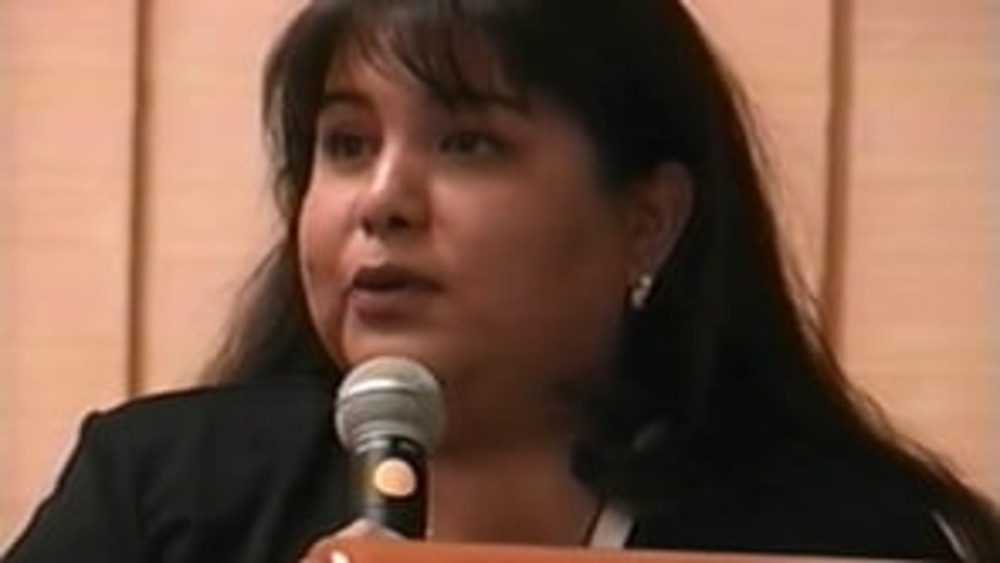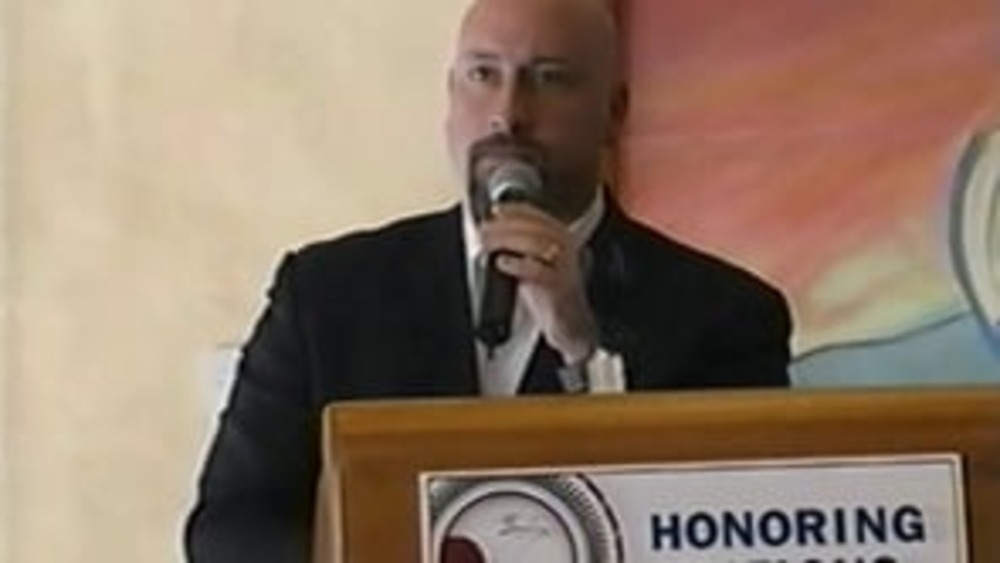Miriam Jorgensen, Director of Research for the Native Nations Institute and the Harvard Project on American Indian Economic Development, shares the cross-cutting themes of good governance that exist among the Honoring Nations award-winning programs.
Additional Information
Jorgensen, Miriam. "Achieving Good Governance: Cross-Cutting Themes." Honoring Nations symposium. Harvard Project on American Indian Economic Development, John F. Kennedy School of Government, Harvard University. Sante Fe, New Mexico. February 7, 2002. Presentation.
Transcript
Andrew Lee:
"Now I'd like to introduce my colleague Miriam Jorgensen, who's going to talk about some cross cutting themes of Honoring Nations winners. I think one of the unique things that's happened in this room that I'm not sure if any of you have had the chance to afford to do is sit next to somebody who's work is just entirely different than yours but you share some things in common. And we want to use this opportunity to talk about some of those things that you do share in common and Miriam Jorgensen has thought quite a bit about this issue. She's actually so well liked, so well respected that she splits her time. She lives in St. Louis, Missouri. Harvard University is in Cambridge, Massachusetts, the University of Arizona is in Arizona, obviously, and she has an appointment with both of us. And we just think the world of her and I'm looking forward to hearing some of what these great Honoring Nations winners have in common. Miriam, the microphone is yours and after this we can go upstairs and there's a reception that we're going to end on."
Miriam Jorgensen:
"I appreciated getting to be a fly on the wall during the discussions that took place earlier today when you broke out into groups. And I think that most of you probably hit on a lot of the themes that I'm going to talk about today. And in fact, I probably won't get to all the different ways that these programs have themes in common. But what I wanted to talk about a little bit are, what are some of the underlying elements that show how winning programs have achieved their success? What are those cross-cutting elements? What approaches underlie their positive progress that are shared across programs? And turn that also into, what are some of the lessons that all of this universe of 32 winners from the two years of the program, so far? What are the lessons that they bring to Indian Country and really to the rest of the world, to governments around the world? And what are some of those lessons?
I think one of the first and really outstanding lessons to all this is that programs that have achieved good governance have an ability to measure and track their progress. I think it's certainly clear that we look, as an evaluating team and as the advisory board looks at things, they look for evidence of success and progress but it's... I want to take this farther and say it's not just evidence of your success but looking at measures of progress, looking at measures of success, assessing programs is part of what actually makes programs better. And I think as you think about the work that you do and the work that you've heard your colleagues in excellence do, you see that one of the things they're doing is figuring out how to see that they're meeting their goals and that they're using that information to become even better programs. Let me give you a couple of examples that come from the winners in this room and potentially from some who weren't able to be with us today.
On the purely numeric side -- and you can imagine that there are ways of tracking progress that are quantitative and qualitative and I'll try to give some examples of each -- but on the purely numeric side, I will give you the example of the White Earth Suicide Intervention Team. Now, they are very consciously a suicide intervention team. They don't put the goal out there to prevent suicide, even though they have managed probably to prevent quite a few, but they look for data that says, ‘How is it that we can measure how well we're moving toward this goal of suicide intervention,' and they look for something that would be appropriate that would say, ‘What is it that's really telling us that we're going out there, meeting that mark that we care about of suicide intervention?' Well, it turns out that one of the things they decided to track was 72-hour holds. In the early 1990s, as the team was just forming and beginning its work, about six percent of the individuals who had attempted suicide and they were rushed to emergency rooms or hospital, only six percent were held in the hospital for 72 hours for observation and holding. This is a common intervention procedure, a prevention procedure but only six percent of the members of the White Earth Tribe who had attempted suicide were being held. As the team began its work and tracked its innovations, it tracked its progress on trying to increase the number of 72-hour holds. This was really fantastic progress because you have to understand, White Earth doesn't have a hospital. All the hospitals that it's dealing with are non-native hospitals, off reservation or within the reservation but are not controlled by the tribe. So it's working with outside entities to make them live up to their responsibility to their native patients. By the late 1990s over 70 percent, up to about 77 percent of the individuals from White Earth who had attempted suicide and were then placed in emergency rooms in hospitals were on 72-hour holds. So they used this data as a tool, they said, ‘Here's something that's going to track our progress, that can measure our success, that shows us where we're going,' and they used it to set the bar and to set the mark and track their progress in that way. And their goal of course is to try to have 100 percent. So you can see how they used data to measure their success, move toward it and to challenge themselves to do even better.
Now it doesn't have to be that it's just numeric data that is the kind of assessment tool that you can use to measure progress. I think a number of the programs in this room are looking at what they do and they say, ‘Look, yeah, we also use information and data to assess our progress that's not necessarily quantitative. It can be more qualitative.' One example is the Grand Traverse Planning and Development Department. One of the things that they've done is say, ‘Hey, are we doing what we said we'd do? Are we making progress? Are we achieving our goals?' Let's create a list of very achievable goals, much of it generated from community input in a very innovative way, and they sit down and they deliberately track their progress toward meeting those goals. So that's a more qualitative approach of using information and data, of improving their programs. So those are just a couple of examples to show you that one of the cross-cutting themes, one of the things that we see all successful programs doing, all the winners sitting in this room is that they use assessment information to track their progress, measure their progress toward their goals and to challenge themselves to do better and I think that's something that all the programs do.
Another thing that I think all the programs do is that they've achieved good governance oftentimes by tackling really hard problems, and using those hard programs as motivators, and using their success with having tackled those programs or problems as further motivation. Now what do I mean by this? What are some examples we see out there? Think to yourself about all the situations you see in Indian Country and beyond where governments and citizens allow themselves to be sort of beat down by how hard the problems are that they face, whether or not it's like a White Earth suicide problem or the challenges of implementing technology that can help them or the negotiation kinds of problems that we've heard about. Those can be really difficult problems to face. They can be immobilizing in the face of that difficulty. But one thing we see across all the winning programs, a common strand, is a willingness to take up those challenges, to not see a hard problem as something to just bend over in front of but rather to say, ‘What can we do about this?' and then to use that as motivation.
One of the really exciting and incredible hard problems that one of our winners has tackled was the Louden Tribe of Alaska and their Yukaana Development Corporation. Now Yukaana doesn't have a lot of control over the land that the U.S. Air Force had polluted, but they decided that because it was their traditional territory they really wanted to do something about it and this was a mandate from the community that they try to do something about it. They said, ‘Look, this is a huge challenge. It's something that in a sense we don't even have authority and control over but we're going to use that as motivation to try to do something about it.' And they did, with the formation of YDC, the Yukaana Development Corporation, they were able to clean up over 12,000 50-gallon drums of petroleum waste and 3,200 barrels of tar out of that area. They trained hundreds of people in their workforce to solve problems in their area and beyond. They were able to take this really hard challenge and say, ‘We can do something about it.' And in fact, in reflecting on their success with that, it's also been a motivator to even greater work for that organization. So that's one of the things I mean about when you look across these programs, one of the things that they evidence is an ability to take up those hard challenges, to not just say, ‘We can't do something about it,' but to use the difficulty as a motivator to move forward and then also to use the success, once they've achieved that, as further motivation. So good government is achieved as leaders and program directors accept big challenges and use them for inspiration.
I think it's also clear again, as we look across the universe of programs, that programs that have achieved good governance as were spoken about in the presentations earlier as well, they create distinctly Native approaches for local solutions and by doing so this has distinct benefits. What do I mean? Well, I think that it's important to understand that, for instance, self-determination, that's just not about Indian people managing programs for other Indian people. It's about creating special programs that are uniquely native that have uniquely local approaches embedded in them and that definitely has benefits. One of the benefits that we see is that by creating programs of this sort, it's often the case that those solutions are much more workable, are better solutions than externally imposed style solutions.
One of the best examples of this I think from the universal winners is the Navajo Child Special Advocacy Project. This is a program that addresses again a really hard problem, child sexual abuse on the Navajo reservation and they've said, ‘We're not just going to do our therapy and our interventions in a western style. We're going to wholly integrate Navajo approaches into our treatment and into our program development.' And in so doing, they're able to create a more holistic program, a program that serves more of the child's needs to bring in both the western approaches and the Navajo approaches, to address it within the cultural context of harmony and critically they also then serve whole families which many programs of this sort do not do. So therefore they're able to be a more successful, better and improved program as a result of the fact that they've integrated these cultural approaches.
I think one of the other things that having a more cultural local approach does is that it actually generates positive results for Native culture as well. To me, one of the examples here is that it's frequent for us to hear, maybe it's not Indians, maybe it's even detractors within the Indian community saying, ‘Well, if you pursue that kind of highly high-tech solution or if you pursue that really highly institutionalized organized bureaucratic approach you're losing your 'Native-ness'; you're not going to be Indian anymore if you do it that way.' But I think there's strong evidence that says there are ways to do even really progressive, innovative, interesting modern programs that promote and preserve culture. A couple of examples of those are like the Mille Lacs and Ojibwe language programs, where they're using modern approaches like rap music and computer technology to promote and improve language learning within that culture. Here's a place where technology has been controlled by the tribe instead of having it denigrate culture it's building up culture.
Another thing is that it's also the case that it's possible to use highly organized, very capable institutions to promote culture and I think this is one of the examples that we see from one of the speakers this afternoon of the Poeh Culture Center. Here's a case where you've got this very technologically innovative advanced idea of saying, ‘Let's have our construction services firm support our artists and we're going to have a bureaucratic structure, which allows them to have a place to do their work and to sell their art.' Now that means we've got this highly capable institution, helping move forward the culture. It's not drawing the culture down. It's not eliminated the culture. It's moving it forward. So again, good government is achieved as tribal governments use and expand local and cultural knowledge as they carry out their programs because it makes the programs better and it also promotes the culture of that community.
I think the last thing I want to say, and this is really inspired. I thought about this one a little bit less but it's inspired by listening to the conversations this afternoon and talking to members of the advisory board who have been engaged on these issues as well. I think it's really clear that programs that have achieved good governance are administered in ways that promote sovereignty. I think that in a sense not enough can be said about this point. As we all reflect on the conversations of this afternoon and on the work that you've done, that you can see that the programs that you carry out have achieved good governance because they are promoting sovereignty. I think they do this in two different ways. One is through institutional capability. Charlie O'Hara mentioned this a little bit just a little bit ago where he talked about when you have the technical expertise, the institutional expertise, it's very hard for outsiders to look at you and say, ‘Hey, you can't do that. You're not capable of running that program.' So by having strong institutional capacity, as they do at the Swinomish Cooperative Land Use Program, as they do at the Jicarilla Fisheries and Wildlife Program at the White Mountain Outdoor Recreation Program. These have strong institutional capacity that prove to outsiders that native nations are highly capable of managing programs and taking control of that sovereignty.
I think one of the other ways they do it is that programs like yours have been very strategic in figuring out ways to promote sovereignty of the nation through programs operations. This is clear in the work that, say, Justin does at Grand Ronde through the Grand Ronde Intergovernmental Relations Department, strategically following paths that expand the sovereignty of the nation. So that would be the point on which I conclude, that I think as we look across the universal programs, one of the other things that's a common denominator and a common strand is that good governance is achieved as programs promote and underwrite the sovereignty of their nations.
So those are the reflections that I had as I thought about the work that you're doing. I didn't mention all 32 programs in the room, but I think these elements and strands are reflective of the work that you all do, which is commendable and I'm very pleased to have learned from you and I'm excited to share these lessons with other nations both Indian Country and beyond."



